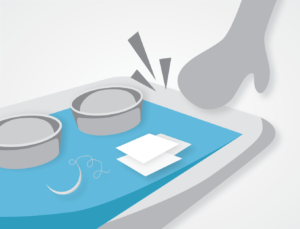As a company that specializes in improving healthcare products and systems, Design Science often needs researchers to perform observations in the operating room (OR). My work typically involves human factors usability studies and evaluations, so I was excited to be given the chance to participate in my first surgical ethnographic timing study!While working on this project, I learned about the preparation required for a researcher as she steps into the surgeon’s carefully controlled environment.
1. Prepare for the specific surgery
 Be sure to familiarize yourself with the steps of the procedure and the different instruments that will be used.
Be sure to familiarize yourself with the steps of the procedure and the different instruments that will be used.
The first thing I needed was an understanding of the surgery itself. A simple internet search provided animated and real-life videos of the procedure, which allowed me to familiarize myself with the expected workflow. After this research, I created a simple outline of the surgery; I could now identify which tools and techniques would be used during the different steps of the procedure. This allowed me to identify the key moments that would impact my study.
It was also helpful to identify the types of diagnoses that led patients to need this surgery. Case variations can occur, depending on the different patients’ medical histories, and it was important to understand which elements might lead the surgeon to veer from the standard course of care.
2. Understand the operating room environment
Once I entered the surgical environment, I became a part of a precisely orchestrated chain of events designed to maximize quality health care and patient safety. The surgeon controls every aspect of his environment as he works with surgical and circulating nurses, anesthesiologists, assisting doctors, and other staff members.
The researcher must adhere to this rigorous standard of sterility by wearing clean scrubs, a surgical cap, and a face mask at the very least. The hospital provides these pieces, but you may need to ask for them. It is important to be vocal if you need something or have questions about the operating room procedures.
During one of my first visits, I forgot to put on shoe covers and tracked dirt into the OR. The nurse who caught this reinforced that the prevention of contamination is a responsibility that falls on each person who enters the room. Luckily, the problem was resolved prior to the surgeon walking into the room; impacting the sterility of the OR is a quick way to lose the trust of a surgeon. It is crucial to have a good understanding of the surgical standard of cleanliness, both to keep the patient safe and to maintain your relationship with the surgical staff.
3. Establish a relationship with the surgeon
 While it's important to be respectful of the physician's need to focus on his work, it is often valuable to build a rapport with him prior to the procedure.
While it's important to be respectful of the physician's need to focus on his work, it is often valuable to build a rapport with him prior to the procedure.Since the surgeon ranks at the top of the OR hierarchy, I knew it was important for him to be comfortable with my presence in the room. I found it helpful to ask questions about the surgical plan or patient demographics prior to the start of the procedure. This time was valuable because it allowed me to clear up any confusion I had about the workflow and define any unfamiliar vocabulary I had heard. While the surgeon did not expect me to be an expert on the medical nuances of the procedure, this was a chance for me to demonstrate that I was familiar with it and knew what to expect during the case.
Lastly, I found it important to relate to the surgeon on a personal level. If you are interested in the work that he’s doing and fascinated by the procedure you are observing, express that! I found that the surgeons, like many of us, loved talking about their job and their passion for medicine. Talking to the surgeon about where he is from or asking for suggestions about things to do in the city I was visiting were great ways to break the ice and relate on a more personal level.
---
Overall, I greatly enjoyed my introduction to operating room ethnography! While there are many other elements that go into ensuring a surgical observation will be successful and valuable, following the tips above will help you start as a safe and productive researcher in a chaotic environment.
Interested in learning more about real use environments? Contact us to discuss how this research could improve your product or enable you to expand your company’s reach.
Think this work sounds exciting? We’re always looking to connect with talented researchers and analysts, so feel free to reach out and tell us why you’d be an asset to the Design Science team!
This post was edited by Lindsey Stefan.
Share this entry
-
Share on Facebook
Share on Facebook
-
Share on Twitter
Share on Twitter
-
Share on Google+
Share on Google+
-
Share on Linkedin
Share on Linkedin
-
Share by Mail
Share by Mail












